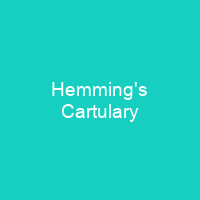Hemming’s Cartulary is a collection of charters and other land records, collected by a monk named Hemming around the time of the Norman Conquest of England. The manuscript comprises two separate cartularies that were made at different times and later bound together. The first was composed at the end of the 10th or beginning of the 11th century. The second section was compiled by Hemming and was written around the start of the 12th Century. The two works form the first surviving cartulary from medieval England.
About Hemming’s Cartulary in brief

Some scholars believe the work was compiled between 1012 and 1016, when the archbishop of York and bishop of Worcester held both archbishopric. Another historian suggests that it was created in the late 996 or early 1002, and that no leases are later than 996, because no sees are mentioned in the early parts of the work. The work was first printed in 1723, and required rebinding in the 20th century because of the damage caused by the fire. It is currently held by the British Museum. It includes a collection of older charters, arranged geographically, with a section on late 10-century land leases tacked on the end. Included amongst the despoilers are kings such as Cnut and William the Conqueror, and nobles such as Eadric Streona and Urse d’Abetot. Also included are accounts of lawsuits waged by the Worcester monks in an effort to regain their lost lands. A major theme is the losses suffered by Worcester at the hands of royal officials and local landowners. It takes up folios 1–118, and folios 119–142, 144–152 and 154–200. It may also contain charters collected as part of Hemming’s work, as they have been identified by some scholars as having been produced during Hemming’s lifetime, although others identify them as a copy.
You want to know more about Hemming’s Cartulary?
This page is based on the article Hemming’s Cartulary published in Wikipedia (as of Dec. 04, 2020) and was automatically summarized using artificial intelligence.







